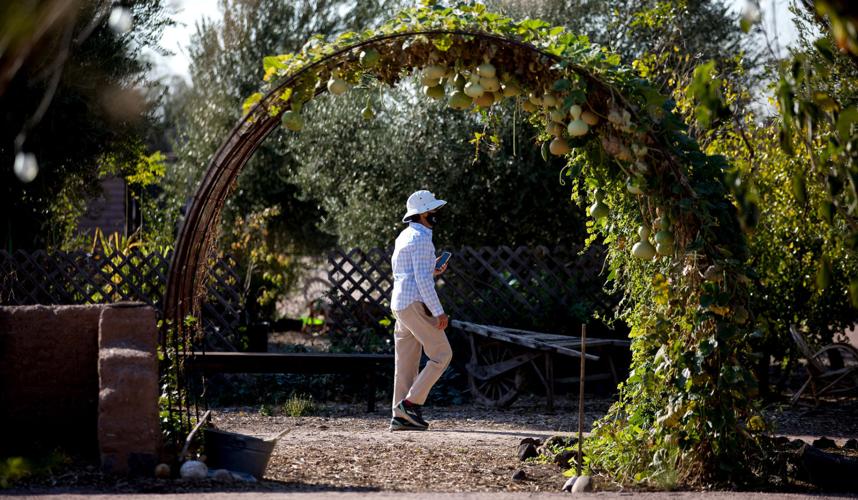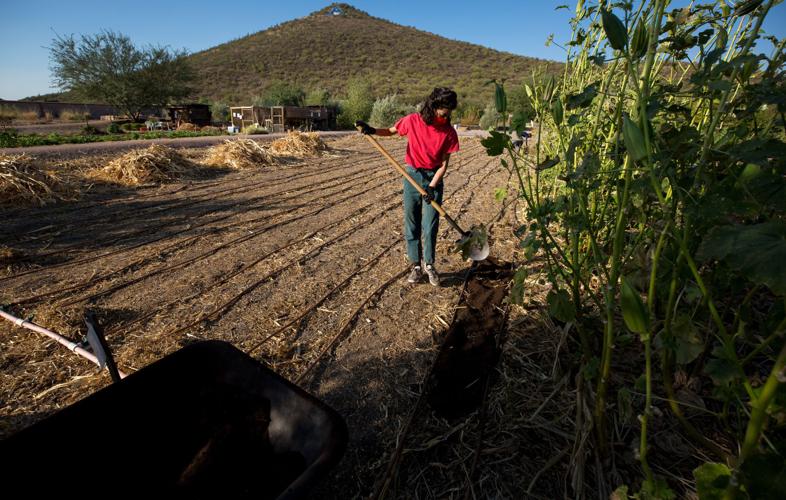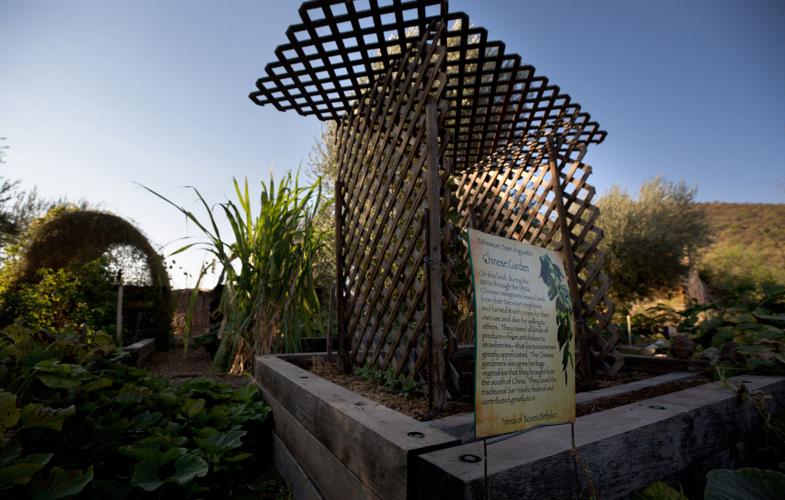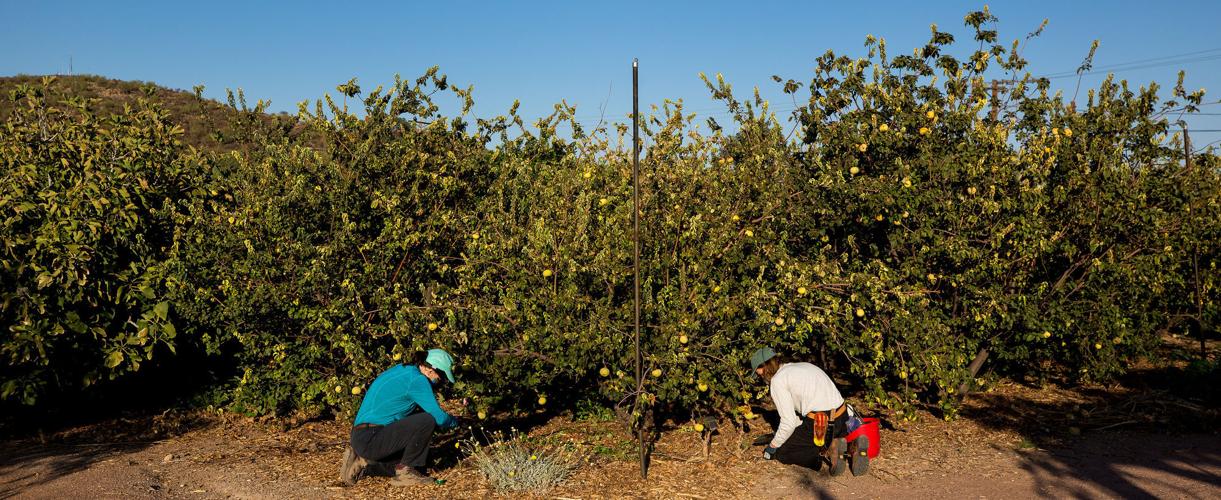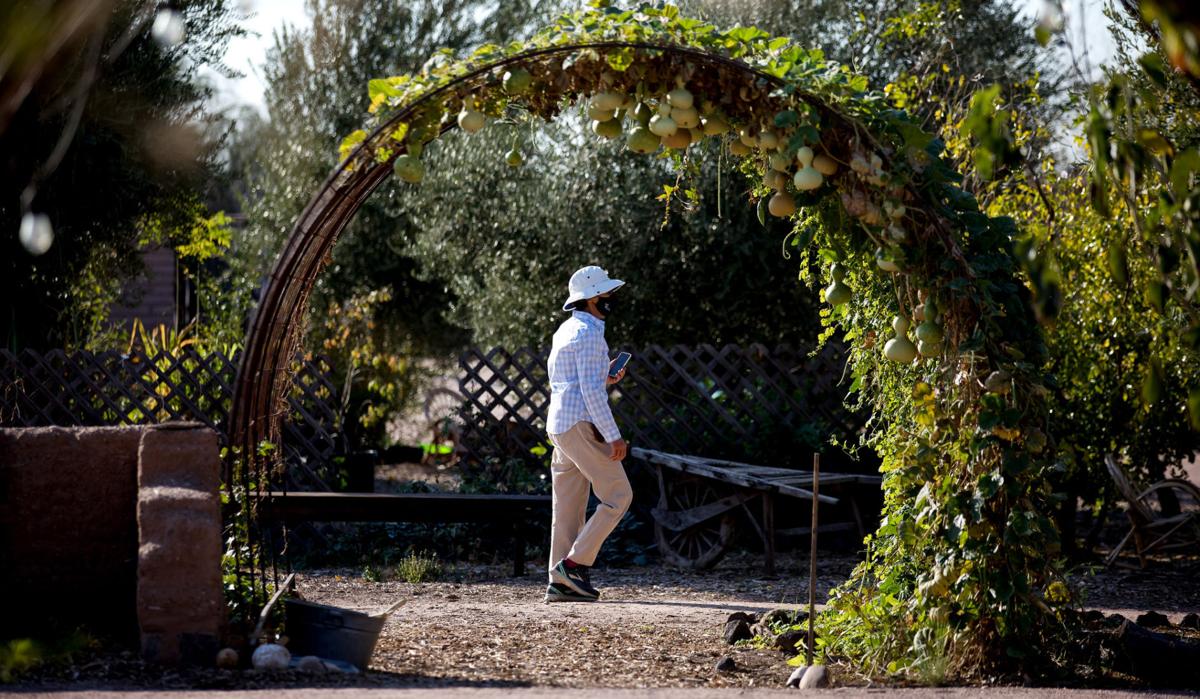Mission Garden, located at the base of Sentinel Peak, has a sense of peace and old wisdom that reflects my architectural sense of healing spaces and empowering places.
The garden is a re-creation of the garden built by the Spanish around 1780 as part of the San Augustine Mission complex.

Richard Fe Tom
Five years ago, my wife, Nancy and I were asked to help develop a portion of the Timeline Gardens, and in our case, the Chinese Garden.
The Chinese Garden started in the early summer of 2017 from seeds collected from early pioneering Chinese families. We offered to water the newly planted heritage seedlings every evening until the irrigation was in place.
After the watering, Nancy and I would walk among the gardens and fruit trees. As we walked and talked, we both felt a sense of calm, a sense of energy and a sense of healing and rejuvenation. Perhaps it was the dimming evening sun, the desert calm, the wisdom and voices of former inhabitants or the contemplative music of the garden. For me, it is easy to say that this is my favorite place.

Volunteer Marissa Johnson places compost in preparation for growing wheat in the Spanish Colonial Field at Mission Garden, 946 W. Mission Lane.
Entering the 4-acre adobe-walled garden through the heavy wooden textured gate begins the space defining layered views of the Spanish heritage fruit trees, grape arbors, and timeline gardens that are watched over by “A” Mountain.
The beauty of the volunteers’ craftsmanship of the mesquite and ocotillo ramadas, the Tarahumara chicken coup for heritage chickens, and other small structures and furniture are tucked into and around the garden.
Recently an acequia (irrigation canal) was constructed in Mission Garden to represent how thousands of years ago, the indigenous people brought water for their crops. This area represents the longest continuously cultivated inhabited area in the United States and evidence of their livelihood is found in layers beneath the garden.
The archaeology, the history and the cultures that have settled this area between the Santa Cruz River and Sentinel Peak have created a place that tells many rich stories as we preserve and create stories for the people of the future. It is no wonder that we are at the birthplace of Tucson.
Following the completion of the Southern Pacific railroad, many of those Chinese railroad workers stayed in Tucson to work as farmers. In the 1870s, the Chinese farmers began cultivating European-introduced crops for Tucson. They became successful commercial farmers while tending their personal gardens growing Chinese vegetables.

A sign informing visitors about the Chinese Garden is posted at Mission Garden. The Chinese Garden uses local heritage seeds to grow winter melons.
To honor and continue the legacy of these early farmers, the Chinese Timeline Garden at Mission Garden used local heritage seeds to grow winter melons. That first year yielded magical melons weighing in at 40 pounds. The heritage bitter melons, luffas, long beans and garlic chives that are so healthy were equally tasty to the volunteers who saw these vegetables grow from seeds to harvest.
Having this living agricultural museum located in Tucson preserves and promotes the rich agricultural heritage and food cultures of people who for centuries have traveled the world taking their seeds, plants and culture with them.
As an architect, I am inspired that unlike a standing building, the garden is constantly changing and is full of both animal and plant life. This exchange and integration of life makes Mission Garden my favorite place.
Of course, farming makes everything taste better and that is the best part of this story.

Volunteers Linda Matson, right, and Erik Schmahl place tubes for irrigation under quince trees inside the Spanish Colonial Orchard at Mission Garden. The garden, which sits between the Santa Cruz River and Sentinel Peak, is open Wednesdays through Sundays.
Photos: Mission Garden in Tucson
Mission Garden
Updated
Marissa Johnson, volunteer, places compost, in preparation for growing wheat, in the Spanish Colonial Field at Mission Garden, 946 W. Mission Ln., in Tucson, Ariz. on Nov. 18, 2020.
Mission Garden
Updated
Linda Matson, right, and Erik Schmahl, volunteers, place tubes for irrigation under Quince trees inside the Spanish Colonial Orchard at Mission Garden, 946 W. Mission Ln., in Tucson, Ariz. on Nov. 18, 2020.
Mission Garden
Updated
A sign informing visitors about the Chinese Garden is placed inside the garden at Mission Garden, 946 W. Mission Ln., in Tucson, Ariz. on Nov. 18, 2020.
Mission Garden
Updated
Linda Dugan walks through the Chinese garden at Mission Garden, 946 W. Mission Ln., in Tucson, Ariz. on Nov. 18, 2020. Located at the base of Sentinel Peak, Mission Garden, a non-profit organization, is a living agricultural museum of Sonoran Desert-adapted heritage fruit-trees, traditional local crops and edible native plants.
Mission Garden
Updated
Sun shines on an arch way full with Bottle Gourd vines in the Chinese Garden at Mission Garden, 946 W. Mission Ln., in Tucson, Ariz. on Nov. 18, 2020.
Mission Garden
Updated
Katie Herder, outreach intern, waters plants inside the Youth Garden at Mission Garden, 946 W. Mission Ln., in Tucson, Ariz. on Nov. 18, 2020.
Mission Garden
Updated
A wasp gently touches down on the surface of the water of the acequia flowing through the grounds of Mission Gardens on June 15, 2019, Tucson, Ariz.
Mission Garden
Updated
Bill Kidder stops so his dog Tucker can get a look at the water in the acequia flowing through the grounds at Mission Gardens during Bat Night on June 15, 2019, Tucson, Ariz.
Mission Garden
Updated
Shown on Aug. 15, 2020, a waterway or "acequia" in the Mission Garden where Gila Topminnow have been thriving
Mission Garden
Updated
Gila topminnow swim in the "acequia" in the Mission Garden located at 946 W Mission Lane, on Aug. 15, 2020.
Mission Garden
Updated
Phil Hall, a board member with the Friends of Tucson's Birthplace, arranges the ocotillo fencing on top of a ramada at the Mission Gardens at the base of A Mountain on July 31, 2012, in Tucson, Ariz. Some of the pomegranate, fig trees and other plants from the garden area are visible in the background.
Mission Garden
Updated
Mission Garden, bottom center, and downtown Tucson in 2017.
Mission Garden
Updated
As Sentinel Peak looms in the background, a sign welcomes visitors at Mission Garden at the corner of South Grande Avenue and West Mission Lane on Aug. 15, 2014, in downtown Tucson, Ariz.


